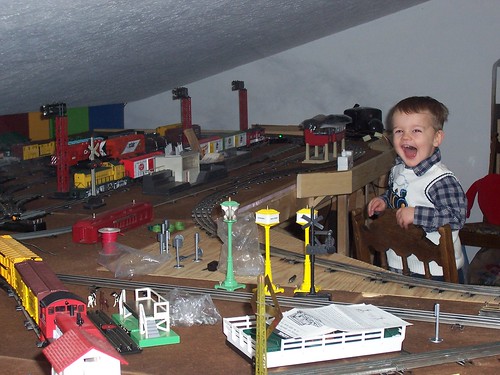 Like many people I had toy trains as a kid. It was nothing huge or elaborate but my dad and I (well, mostly my dad as I was about 10) built a 4'X8' table in our basement with an HO layout on it. It was fun and I enjoyed adding buildings and stuff to it but it never really 'grabbed' me.
Like many people I had toy trains as a kid. It was nothing huge or elaborate but my dad and I (well, mostly my dad as I was about 10) built a 4'X8' table in our basement with an HO layout on it. It was fun and I enjoyed adding buildings and stuff to it but it never really 'grabbed' me.
Fast forward a few many years and here I am playing with trains again. This time they are bigger, O Gauge instead of HO Gauge (1/48 scale instead of 1/87 for those not 'in the know'). And while there is still the fun of watching trains run around the track, and seeing the pure joy on my son's face while watching them would make anything better, there is something more this time. Trains are 'smarter' then they were when I was a kid. Current trains are fun for the geek in all of us (at least the geek in everyone reading a programming blog).
The two largest companies in O Gauge railroading today are Lionel and MTH. Lionel is the same company that made the trains your granddad played with. MTH is a newer company but still very much into it, and the competition between the two helps them each do some great things. Now I'm not saying that these guys are all these is, far from it, they just are the biggest. There tons of companies that make all sorts of stuf. You can even buy track that is so realistic it comes with wooden ties that are spiked to the rails like real track!
But what is cool for geeks? I'll tell you :)
New engines from either company have a ton of features other than go & stop. I have a remote control from MTH that lets me blow whistles, sound bells, launch station announcements, cause train wrecks, adjust volume, drop cars and a ton more. And I can do this for multiple engines at one time, while walking around the room. Trust me, it's a lot more fun than it sounds. You have total control over multiple engines, can throw switches and even operate accessories, all from the one remote. The home theater market could learn a thing or two from these guys :).
Also for geeks, there is the planning. You can't just throw track on a board and hope it all fits. There is software these days to help you determine what the layout will look like (and if it will fit). This software makes it easy to figure out how much of what type of track you can fit in the space you have available. You can even look at your layout in 3d and give it accessories, buildings and mountains.
And then there is the wiring. A simple loop requires simple wiring, a couple of wires going to a lock-on (easy device for connecting wire to track) and you are done. The more complex the layout, the more complex the wiring gets as well. My layout shown here has 18 switches, three separate loops (each in numerous blocks), six sidings and numerous operating accessories. All of these items require their own wiring, some needing soldered to toggle switches or screwed onto terminal posts. You can't see even a fraction of the wiring from this one picture and this isn't even done. That piece on the left will have about 20 sets of three lead wires heading into it soon.
Really I'm not quite which is more fun. Playing with the trains or building the layout.

No comments:
Post a Comment